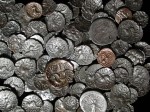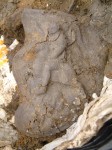 In 2000, a group of archaeologists and volunteers discovered some Iron Age pottery outside the village of Hallaton in Leicestershire, central England. A metal detectorist followed up in the area and found gold and silver coins. Further excavation revealed they had found one of the most important Iron Age sites in Britain, complete with 333 Roman coins, 5,296 British-made silver and gold coins, jewelry, ingots, thousands of pig bones, complete skeletons of three dogs and the pièce de résistance: an elaborately decorated Roman cavalry parade helmet that was buried around 43 A.D., the year of Claudius’ invasion of Britain.
In 2000, a group of archaeologists and volunteers discovered some Iron Age pottery outside the village of Hallaton in Leicestershire, central England. A metal detectorist followed up in the area and found gold and silver coins. Further excavation revealed they had found one of the most important Iron Age sites in Britain, complete with 333 Roman coins, 5,296 British-made silver and gold coins, jewelry, ingots, thousands of pig bones, complete skeletons of three dogs and the pièce de résistance: an elaborately decorated Roman cavalry parade helmet that was buried around 43 A.D., the year of Claudius’ invasion of Britain.
The discoveries indicate that the site was a major Iron Age hilltop ritual enclosure, an important religious center for the local inhabitants, primarily the Corieltavi tribe. The pig bones were buried at various times during the 30s A.D., some of them remains of huge feasts while others were buried with the joints intact as a sacrifice to the gods. Because of the careful placement of the dogs’ remains, archaeologists believe the dogs were intentionally killed and buried to guard the shrine.
 The valuables buried underscore the importance of the site. The hoard of Iron Age British coins is the largest ever found in Britain, comprising almost 10 percent of all extant British Iron Age coins. Among the 333 Roman coins found was the oldest Roman coin ever found in Britain: a silver denarius dating to around 211 B.C. It was buried by the Corieltavi in the 40s or 50s A.D. The images of Roma on the obverse and the Dioscuri (the twins Castor and Pollux) on the reverse are extremely worn, meaning that that denarius traveled far and wide for about 250 years before being put to rest in Leicestershire’s loam.
The valuables buried underscore the importance of the site. The hoard of Iron Age British coins is the largest ever found in Britain, comprising almost 10 percent of all extant British Iron Age coins. Among the 333 Roman coins found was the oldest Roman coin ever found in Britain: a silver denarius dating to around 211 B.C. It was buried by the Corieltavi in the 40s or 50s A.D. The images of Roma on the obverse and the Dioscuri (the twins Castor and Pollux) on the reverse are extremely worn, meaning that that denarius traveled far and wide for about 250 years before being put to rest in Leicestershire’s loam.
 Then there’s the helmet. It was found in thousands of pieces, the metal so corroded archaeologists joked that they’d found a “rusty bucket” this time. The pieces were embedded in the mud; archaeologists had to remove the whole block of soil encased in plaster of Paris to get it to the conservation lab. There they discovered the rusty bucket was a silver-gilt iron cavalry parade helmet, the cheekpiece decorated with the figure of an emperor trampling a barbarian under the hooves of his horse while a winged victory holds a laurel wreath over his head.
Then there’s the helmet. It was found in thousands of pieces, the metal so corroded archaeologists joked that they’d found a “rusty bucket” this time. The pieces were embedded in the mud; archaeologists had to remove the whole block of soil encased in plaster of Paris to get it to the conservation lab. There they discovered the rusty bucket was a silver-gilt iron cavalry parade helmet, the cheekpiece decorated with the figure of an emperor trampling a barbarian under the hooves of his horse while a winged victory holds a laurel wreath over his head.
 It’s one of a very few Roman cavalry helmets ever found in Britain and one of the earliest. It’s also the only Roman helmet found in Britain with most of the silver plating surviving, even though it’s too corroded to shine anymore. This would have been owned by a cavalry officer of high status. There’s speculation that it could even have belonged to a Briton in the Roman army who buried it as a sacrifice, although of course there’s no way to know who owned it, who buried it and why.
It’s one of a very few Roman cavalry helmets ever found in Britain and one of the earliest. It’s also the only Roman helmet found in Britain with most of the silver plating surviving, even though it’s too corroded to shine anymore. This would have been owned by a cavalry officer of high status. There’s speculation that it could even have belonged to a Briton in the Roman army who buried it as a sacrifice, although of course there’s no way to know who owned it, who buried it and why.
A Heritage Lottery grant allowed British Museum conservators to piece it back together like a 3D puzzle. It took them ten years.
Metals conservation expert Marilyn Hockey began unearthing the fragments “out of a big lump of soil” at the British Museum three years ago.
She said: “Working our way down this enormous lump of clay, we discovered at the bottom some amazing finds … the Emperor cheek piece told us it was something really special. To get something straight out of the soil like this is like gold. You can find out so much from it.”
Jeremy Hill, head of research at the British Museum, said his “mouth dropped” when he saw the object pieced back together.
He said that the helmet had helped “change our understanding of what Britain was like just before the Roman conquest”.
He said: “Every book on the Roman conquest of Britain is going to have a picture of that helmet in it now.”
Next up for the Hallaton Helmet is permanent display at the Harborough Museum, just nine miles from where it was discovered, along with many other pieces of the Hallaton Treasure. For more details about the finds and tons more pictures, please see the Leicestershire County Council website. There’s video of the restored helmet here. For more about the conservation, see the British Museum blog.
Liv; When are you going to set up a grand tour of England to see all of these fascinating sites you have written about? I bet you could fill a plane full of takers in under an hour–and charge more than those high-buck National Geographic excursions.
You are full of good ideas. My mom used to dream of leading walking tours of Rome since she did them for family and friends for free all the time. We could go into business together! :boogie:
If face time with the elusive L.D. was part of the package, I imagine that we could fill a plane in ten minutes flat — even if the ultimate destination was a Burger King on the outskirts of Trenton, NJ. I recall a favorite sport of a by-gone era: “Garbo spotting”!
Burger King tastes like lighter fluid. How about the Wendy’s in the Vince Lombardi Service Area on the Jersey Turnpike?
:no: :no: :no: :no: :no: :no: :no:
i am persian
I do metal detecting and I’d love to find a helmet like that one day. If anyone is interested in collecting British coins I would recommend checking out this forum British Coin Forum the members on it are very knowledgeable and helpful.